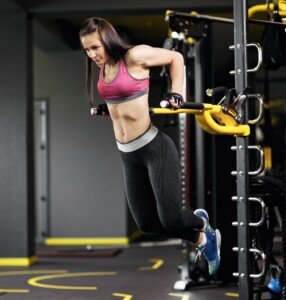
In the past decade I have seen maybe three woman, besides my clients, doing unassisted parallel bar dips. Why is this?
Why don’t women do parallel bar dips without assistance? Can women learn to do such parallel bar dips? Of course they can!
I’m a certified personal trainer, and I myself do unassisted parallel bar dips (I’m a woman) as part of my triceps routine, and I attach weight to my waist, to boot.
The reason is clear why women don’t do parallel bar dips: They are freaking difficult.
The average man off the street can’t do a parallel bar dip attempt much better than the average woman.
That is how hard they are. It’s a completely unnatural motion. If you clicked on this article, you know what a parallel bar dip is, so I’m not going to describe it.
A woman does not need to be skinny to do a parallel bar dip, though if a woman is overweight, even slightly, this will be pretty much like a lean woman trying parallel bar dips with a 20-pound weight plate strapped to her waist.
Here are the prerequisites for learning parallel bar dips, whether you’re a man or a woman.
1. Having reasonable weight for your height. I wouldn’t recommend this workout for people who need to lose a lot of weight.
2. No rotator cuff problems. If you have tweaky shoulders, let alone some kind of rotator cuff problem, then stay away from parallel bar dips.
Here is the training regimen for achieving unassisted parallel bar dips–even if you’re a woman–yes!
1. First do two or three rope drop-sets of triceps push-downs, or your standard seated dip routine.

Shutterstock/GlebSStock
Then you can do a few easy sets of seated chest presses to loosen up the rotator cuff and chest. This will get the blood circulating before the workout.
Never attempt parallel bar dip training on cold, stiff shoulder joints. A little pre-fatigue is very good for them.
Next, stretch your shoulder joints in between sets. Then find a Gravitron or some other type of dip-assist apparatus.
2. Set the assistance such that you can easily dip 12 times. This first set is strictly to loosen up and stretch the shoulder area even further.
3. Your arms should never bend more than 90 degrees. Keep your back straight. Do not pitch forward as you dip. Many women pitch way forward on these machines.
A little pitching is fine, but be very aware of how much you’re tilting forward. When you get to 90 degrees, hold it there for 2-3 seconds.
When you push back up, do not lock out your elbows. Come back down after half a second.
4. Now, set the assistance so that you can barely get out eight reps; the last two or three should be very difficult. Repeat the techniques from No. 3 above, including that 2-3 second hold.
5. Rest 90-120 seconds. You may think this is too long a rest. If you do, then the assistance you’re using is too much, believe it or not.
The effort for the last two or three reps should literally take all you’ve got. If it’s too difficult to do eight, then adjust the assistance.
Strive to lower assistance by 5-10 pounds every week until you no longer need it.
6. If you’re already doing independent parallel bar dips, get in the habit of holding the down position for 2-3 seconds.
If you can do more than eight reps this way, attach a weight to your waist with a “dip belt.” Don’t let your body rock as you dip; keep it controlled.
Your body should always be as upright as possible. Do not let it swing such that your chest is tilting towards the floor.
When women do unassisted parallel bar dips, it gets attention, because it is so rare to see women doing these.
It’s common to see women on the Gravitron and like machines using assistance.
But no assistance? I can count on one hand the number of women I’ve seen in my entire life performing this fabulous compound exercise without assistance. It shouldn’t be that way.
 Lorra Garrick is a former personal trainer certified through the American Council on Exercise. At Bally Total Fitness she trained women and men of all ages for fat loss, muscle building, fitness and improved health.
Lorra Garrick is a former personal trainer certified through the American Council on Exercise. At Bally Total Fitness she trained women and men of all ages for fat loss, muscle building, fitness and improved health.
.











